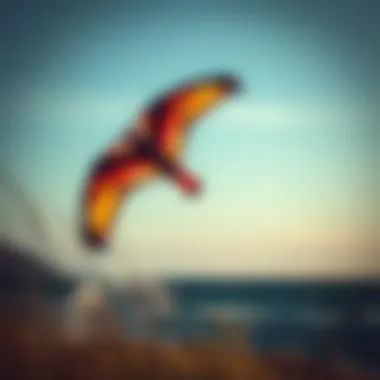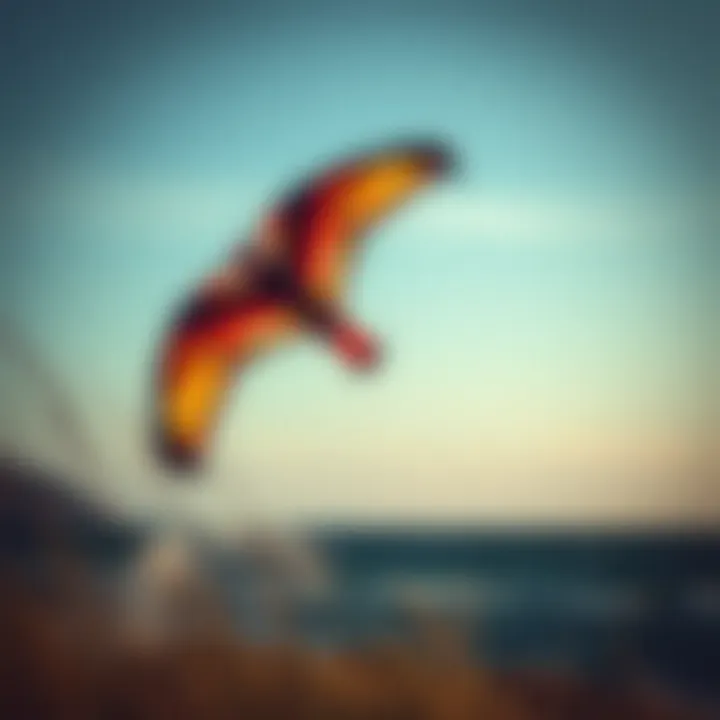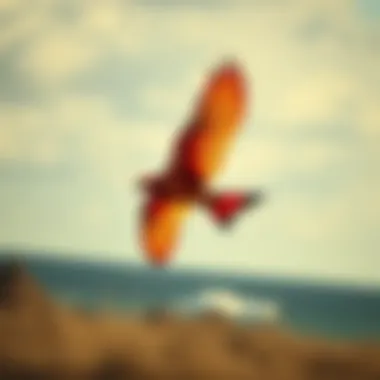Exploring the Phoenix Kite in Kiteboarding


Intro
Kiteboarding has steadily carved a niche in the realm of extreme sports, and at its heart lies the Phoenix kite—a pivotal piece of equipment that has transformed the sport for many riders. This article sets out to unravel the layers of the Phoenix kite, offering insights into its storied past, innovative design features, and performance capabilities. In understanding the evolution of this kite, enthusiasts can appreciate its role not just as a tool, but as an extension of their own abilities in the water and wind.
The Phoenix kite's design principles are not merely arbitrary; rather, they are built on decades of advancements and user feedback. As we gear up to explore these aspects, we will also touch upon essential kiteboarding gear that every novice and seasoned kiteboarder should consider. It’s also crucial to highlight safety practices and training techniques that can help riders optimize their performance while mitigating risks associated with this thrilling sport.
Through the following sections, readers will grasp not only the kite’s functionality but also its impact on the overarching experience of kiteboarding. From selecting the right gear to mastering techniques, the objective is to provide a comprehensive resource that resonates with kiteboarders, adventure seekers, and sports enthusiasts.
Let’s get into the nitty-gritty of kiteboarding gear!
Foreword to Phoenix Kites
Understanding Phoenix kites is paramount for anyone interested in kiteboarding. This kite, known for its distinctive design and excellent performance, plays a crucial role in enhancing the riding experience. With the right kite, conditions can transform from mere activities into thrilling rides.
Definition and Overview
The Phoenix kite is a type of traction kite that stands out not only for its remarkable aesthetics but also for its advanced flying capabilities. Designed specifically for kiteboarding, these kites are engineered to harness wind power effectively. Made from durable materials, Phoenix kites are equipped to perform under a variety of conditions. Their key size and shape allow for a unique flight pattern, leading to better stability and control while needing less user input.
Additionally, these kites come in various sizes. This variation enables riders of differing skill levels—whether beginner or pro—to select the ideal kite for their specific needs. The elegant design does not only serve a visual purpose; it also contributes to aerodynamic efficiency. This efficiency translates into a smoother flying experience, allowing riders to focus more on enjoying their time on the water.
Historical Background
The origins of kiteboarding can be traced back to the late 20th century, but the evolution of the Phoenix kite can be linked to ongoing innovations in careful kite engineering and materials science. In the beginning, kites were simple and often lacked the features that we see today. Early designs were rudimentary, consisting mostly of fabric and tubing, which were less reliable and prone to failure.
A major shift occurred in the 1990s when kite technology began to advance rapidly. The need for better performance led to the refinement of materials such as ripstop nylon, allowing for sturdiness while maintaining a lightweight quality. The rise of kiteboarding as an adventurous sport pushed inventors and engineers to experiment with various shapes and structures, leading to the creation of the Phoenix kite.
From its inception, the Phoenix kite adopted ideas from both delta and C-kites, merging them into a unique style that encapsulates the best features of both designs. The growing popularity of this kite reflected a shift in consumer demand for better performance, driving continuous improvements in design and functionality. Over the years, the Phoenix has enjoyed a loyal following, attributed to its versatility and reliability, becoming a favorite among kiteboarders around the world.
"The development of the Phoenix kite marks a pivotal moment in kiteboarding history, combining tradition with innovation to enrich the sport’s future."
In summary, the Phoenix kite stands as a testament to how far kite design has come, representing a blend of art and engineering that caters to the demands of modern kiteboarders. As we delve deeper into the specifics of the Phoenix kite, this context will help frame the significance of its design and technological advancements.
Design Principles of the Phoenix Kite
Understanding the design principles behind the Phoenix kite is essential for appreciating its effectiveness in kiteboarding. This kite doesn’t simply rely on aesthetics; its construction and engineering are a marriage of function and form, optimized for performance. The choice of materials, shape, and aerodynamics all play pivotal roles, influencing the user experience significantly.
Materials Utilized
The materials chosen for the Phoenix kite are not just about durability but also lightweight performance. Top-tier manufacturers often employ a combination of ripstop nylon and polyester. This fabric isn’t merely sturdy; it creates a balance between weight and power that is central to kiteboarding.
- Ripstop Nylon: Known for its durability, this material minimizes the chances of tears. Riders who are caught in tricky conditions appreciate how this fabric can withstand strong gusts without compromising performance.
- Polyester Blends: These are known for their resistance to UV rays, extending the kite's life significantly. Imagine spending a day under the sun; a kite that can resist fading and degradation is a bonus.
- Reinforced Stitching: This ensures that the seams are tight, holding the kite together even under the most strenuous conditions. Riders often report that this small detail can make a significant difference when navigating challenging winds.
The selection of materials is no minor point; it is a critical element that increases performance and longevity, ensuring that every ride is as seamless as possible.
Shape and Aerodynamics
The shape of the Phoenix kite is another crucial factor in its design. This kite often features a curved leading edge and a swept-back design that enhances its performance in various wind conditions. The key benefits of this aerodynamics include:
- Increased Lift: A well-formed shape generates lift more effectively, helping the kite soar into the skies with minimal effort. This is particularly beneficial for those mastering jumps or tricks, allowing a cleaner takeoff.
- Stability: The design mitigates the risk of luffing, maintaining control even during sudden shifts in wind. Users appreciate that they can navigate easily regardless of changing conditions.
- Enhanced Speed: The aerodynamic design minimizes drag, enabling faster movement across the water. Kiteboarders often find that they can cover more distance in less time, giving them an edge on the water.
"A kite’s ability to cut through the air, staying stable while allowing freedom, is the essence of thrill in kiteboarding."
Technological Advancements
Understanding the evolution of the Phoenix kite is crucial for anyone involved in kiteboarding. This section dives into how technology has transformed the design, usability, and overall performance of these kites. Technological advancements not only enhance the user's experience but also improve safety, accessibility, and sustainability in kiteboarding. Users from various skill levels often seek kites that offer better functionality and adaptability to different conditions. As such, let's explore the specific elements that have contributed to the modern design of Phoenix kites.
Incorporation of Smart Features
The integration of smart technology in Phoenix kites signifies a leap forward in kiteboarding. Smart features carve a niche that resonates well with younger, tech-savvy riders who value performance tracking and enhanced control. For instance, some kites are now equipped with sensors that relay real-time data regarding altitude, speed, and even GPS location back to the rider’s smartphone. This information can actively help users adjust their techniques on the fly, offering immediate feedback that was previously unavailable.
- Performance Tracking: Riders can monitor their performances against previous sessions, pinpointing areas that require improvement.
- Navigate Wind Conditions: Smart technology can assess wind patterns and offer tips for optimal flying.
- Injury Prevention: By analyzing riding data, athletes can avoid risky maneuvers that could lead to accidents.
Such smart features have an undeniable influence on user confidence and performance, making the experience more enjoyable and safer. However, integrating these technologies does come with considerations such as the need for regular software updates and the potential for technology to fail under extreme conditions.
Improved Durability Metrics
Durability is often a decisive factor for any athlete. While kite designs have always focused on maneuverability and performance, advancements in materials and construction techniques have shifted to prioritize longevity. Phoenix kites, for example, now utilize high-strength, lightweight fabrics like ripstop polyester and advanced composites that can withstand harsh weather conditions and heavy use.
- Weather Resistance: Modern materials are far more resistant to UV rays and saltwater, ensuring the kite maintains its integrity over time.
- Enhanced Reinforcements: Critical stress points are reinforced without adding excess weight, allowing the kite to endure the rigors of regular use while still being high-performing.
- Easy Repair Kits: Some manufacturers provide kits equipped with everything a rider needs to patch up minor damages quickly, extending the life of the kite even further.
These durability metrics not only save kiteboarders money on replacements but also offer peace of mind while out on the water, knowing that their gear can handle what nature throws at it.
"With advancements in both smart technology and materials, the Phoenix kite exemplifies a blend of performance with resilience, making it a favorite among enthusiasts of all levels."


As kiteboarding continues to grow in popularity, embracing these technological advancements remains essential. Riders are better equipped than ever to not only enjoy their time on the water but also to elevate their skills and safety through the thoughtfully integrated technologies in Phoenix kites.
Performance Characteristics
Understanding the performance characteristics of the Phoenix kite is crucial for anyone looking to harness the wind effectively and enjoy the sport of kiteboarding. These characteristics dictate how the kite behaves in various conditions, influencing not just performance but also the safety and enjoyment of the rider. Key elements include wind range, responsiveness, stability, and control features. Each aspect plays a significant role in defining the kite's usability and effectiveness on the water.
Wind Range and Responsiveness
The concept of wind range is fundamental to kiteboarding. Simply put, it refers to the range of wind speeds that a kite can effectively operate in. The Phoenix kite shines in this area, engineered to perform well between light and strong winds. This adaptability makes it appealing to a wider audience, from beginners who may encounter gentle breezes to seasoned riders looking to conquer stronger gusts.
Responsiveness, on the other hand, is about how quickly and reliably a kite reacts to the rider's input. An ideal kite should respond sharply when the rider pulls on the control lines; this not only enhances performance but also increases safety. For instance, the Phoenix kite’s excellent responsiveness allows for quick adjustments, which is vital during sudden weather changes or when dodging obstacles in the water.
Benefits of an optimal wind range and high responsiveness include:
- Versatility: Riders can use the kite in various wind conditions, making it suitable for different adventures.
- Control: Enhanced responsiveness means better maneuverability, which is essential for tricks and other advanced riding techniques.
- Safety Margins: A kite that can handle a broader range of winds allows the rider to manage unexpected gusts effectively.
Kites that excel in wind range and responsiveness bridge the gap between novice and expert riders, promoting a shared experience in the sport.
Stability and Control Features
Another critical performance characteristic is stability. A kite’s stability affects how smoothly it flies and how predictable its flight path is. The Phoenix kite excels in this regard, featuring design elements such as a well-balanced frame and carefully shaped canopy that minimize unwanted movement.
A stable kite gives a rider confidence, particularly in challenging conditions where turbulence can cause other kites to misbehave. Maintaining a steady flight path helps the rider focus on their performance and enjoy the ride without excessive worry about losing control.
Control features further enhance the kite’s usability. The Phoenix kite is designed with innovative control systems that allow for precise adjustments and effortless transitions. These features include adjustable bridle settings and user-friendly control lines, which can accommodate different styles of riding.
Cumulatively, these attributes provide numerous advantages for riders:
- Confidence in Flight: A stable kite allows riders to focus more on their skills rather than worrying about the kite's performance.
- Enhanced Performance: Riders can push their limits, knowing they have control over their kite in various conditions.
- Trick Execution: Stability is crucial for executing tricks; the Phoenix kite’s design supports both beginners and advanced maneuvers alike.
With its reputation for performance and user-friendly design, the Phoenix kite stands out as a reliable companion, fostering an enriching kiteboarding experience.
User Experience
Understanding the user experience with Phoenix kites is crucial, particularly for those diving into the exhilarating world of kiteboarding. The beauty of using a Phoenix kite lies not just in its technical specifications but in how it resonates with individuals riding it. A well-crafted user experience surrounds every aspect, from the precise handling and the thrill of agility to the overall satisfaction it brings, making it fundamental for both novice and seasoned riders.
Feedback from Novice Users
For beginners stepping into kiteboarding, the Phoenix kite can be a gateway to endless fun. Novice users often emphasize the kite’s forgiving nature in various wind conditions. They appreciate how easy it is to launch and land, reducing the intimidating learning curve often associated with kites. Feedback centers around the following key aspects:
- Ease of Use: Many novices remarked on the kite’s straightforward setup. A kite that doesn’t take a rocket scientist to assemble makes the first steps into the kiteboarding world feel more approachable.
- Wind Capability: Beginners have found that the Phoenix kite handles light to moderate winds well, ensuring that they can enjoy sessions that might be frustrating with less stable kites. It offers a sense of autonomy that builds confidence in new users.
- Support and Resources: Users also highlight the community backing this kite. There are ample resources online and clubs locally where they can seek help, share tips, and gather insights. This support boosts their learning curve and fosters camaraderie among kiteboarders.
As a result, many novice participants express a willingness to try new maneuvers sooner, facilitated by an experience that feels encouraging rather than daunting. This aspect plays a critical role in converting casual enthusiasts into committed kiteboarders.
Insights from Experienced Riders
For riders seasoned in the sport, the Phoenix kite often serves as a reliable companion that combines performance with versatility. Experienced kiteboarders tend to focus on the nuances of flight dynamics, stability, and potential for tricks. Here are key insights shared by these adventurous individuals:
- Precision Control: Many seasoned riders rave about the kite’s responsiveness to subtle inputs. This feature allows for a significant edge during both casual cruising and aggressive tricks. The precise control empowers riders to execute maneuvers with confidence, whether soaring high or gliding across the water.
- Durability during Extreme Conditions: Riders have also pointed out the kite’s robust build, which withstands varying weather conditions. This durability means fewer interruptions during longer sessions on the water, adding to overall enjoyment.
- Community Engagement: Experienced kiteboarders often dive deep into local and online communities. They appreciate sharing techniques and learning from others’ experiences, thus enriching their own skills further. Forums like Reddit and other kiteboarding-specific spaces allow for rich discussions about gear optimization and ride strategies.
These insights not only underscore the kite’s adaptability but also highlight how the shared experiences create an interwoven narrative among kiteboarders. The essence of user experience with the Phoenix kite doesn’t stop at the kite itself but extends into the relationships and stories that form around it.
"The true essence of kiteboarding with the Phoenix kite lies in the connections we forge, both with the craft and the community."
In this way, the user experience embodies a holistic journey—offering a gateway for novices and a platform for mastery among veterans, making the Phoenix kite a versatile tool in the ever-evolving world of kiteboarding.
Safety Considerations
The thrill of kiteboarding is unmatched, yet it carries inherent risks. Understanding Safety Considerations is crucial for ensuring enjoyable experiences without significant hazards. When flying a Phoenix kite or any other kite, the potential for accidents, both minor and serious, hovers nearby like the wind. This section delves into essential safety practices, fostering a responsible and cautious approach for kiteboarders, adventurers, and recreational athletes alike.
Best Practices for Safe Operation
Operating a Phoenix kite safely requires awareness and adherence to certain best practices. Here are some fundamental tips:
- Pre-Flight Checks: Before hitting the water or the sky, it’s prudent to perform a thorough inspection of your kite and gear. Check for any frays or tears in the fabric; a small rip can lead to larger problems when airborne.
- Know Your Surroundings: Understand the local environment. Are there power lines nearby? Are there other water users? Keeping an eye on potential hazards can help avoid accidents. Always be mindful of changing weather conditions—what seems a light breeze can quickly escalate.
- Proper Launch and Landing Techniques: Launching and landing a kite properly is key to avoiding injuries. Always have a buddy to assist. Make sure your line is clear and free from entanglements. If you happen to be alone, ensure you are in an open area.
- Wearing Safety Gear: Though it might seem like an afterthought, wearing a helmet and a personal flotation device can save lives. Knee and elbow protection can prevent serious injuries upon crashing or falling.
Adopting these practices creates a safer environment for yourself and fellow kiteboarders, fostering an enjoyable experience every time you step onto the water.
Emergency Protocols
Even with the best precautions, things can go south. Understanding Emergency Protocols is essential. Here’s how to be prepared and respond effectively:
- Identify Risks Early: Gain knowledge of common emergencies related to kiteboarding, such as line tangles or falling injuries. Being able to identify risks early allows for proactive measures to avoid them.
- Practicing Quick Releases: Most modern kites come equipped with safety release mechanisms. Familiarize yourself with the quick-release function before riding. In the heat of the moment, knowing exactly how to detach quickly can make a significant difference.
- Communication Signals: Having a clear set of signals with your fellow kiteboarders can help during emergencies. Whether it's a simple thumbs up or a waving hand, communication is vital.
"Preparedness is not only about gear; it’s about mindset. With confidence and knowledge, you conquer the skies responsibly."


- Emergency Contact: Always let someone know where you're heading and when you plan to return. In case of emergencies, having someone monitor your whereabouts can expedite assistance if needed.
- First Aid Readiness: Equip your environment with a basic first-aid kit. Knowing basic first-aid procedures can help in the case of minor injuries, ensuring prompt treatment. An understanding of CPR may also prove invaluable.
By adhering to outlined safety considerations and implementing emergency protocols, kiteboarders can greatly enhance their enjoyment and minimize risks associated with the exhilarating sport of kiteboarding.
Maintenance and Care
In the world of kiteboarding, a well-maintained kite can spell the difference between a joyous ride and a frustrating experience. Maintaining your Phoenix kite is not just about prolonging its lifespan, but also about ensuring safety and optimizing performance. Just like any piece of equipment that faces the elements head-on, taking care of your kite can prevent minor issues from turning into costly problems.
Benefits of Proper Maintenance
Regular upkeep can enhance your kite's durability, improve its flight characteristics, and increase safety while riding. This involves periodic checks and appropriate care practices that not only safeguard your investment but also elevate the experience on the water. The stakes are high when soaring through the wind, and a minor lapse in maintenance can lead to significant mishaps. Therefore, implementing a proactive maintenance schedule makes perfect sense for all kiteboarders, seasoned or newbies alike.
Routine Inspections
A thorough routine inspection should be the cornerstone of your kite maintenance regimen. Before every outing, a quick but detailed overview of your kite can help catch issues early. Here’s what to consider during these inspections:
- Check the Leading Edge: Ensure there are no punctures or bends. A damaged leading edge can significantly affect performance.
- Inspect the Canopy: Look for tears or signs of wear. Small holes can quickly enlarge if not addressed promptly.
- Line Condition: Examine the lines for fraying or knots. Damaged lines can lead to a loss of control or catastrophic failure while flying.
- Bridle Setup: Ensure that the bridle is correctly rigged and free from tangles. Mismatched components here can change the kite’s behavior drastically.
Having a checklist can help keep everything in check. A quick inspection can be beneficial, ensuring all components are ready to fly.
"An ounce of prevention is worth a pound of cure."
Repair Techniques
Despite best efforts, wear and tear is an inevitable part of kite life. Knowing how to perform basic repairs can save you time and money. Common repair techniques include:
- Patching Holes: Use a repair patch kit specifically designed for kites to seal little tears in the canopy. Make sure to clean the surface before applying the patch and follow any guidelines enclosed with the repair kit.
- Re-tying Lines: If you notice frayed lines, replace or re-tie the necessary sections using high-quality material compatible with your existing lines to maintain balance. If in doubt, consult the manufacturer's specifications for the correct repair method.
- Stitching Issues: Should you encounter a seam that is coming apart, you can use a needle and high-tensile thread to stitch it back together. Try to match the original stitching pattern to avoid compromising the integrity of the canopy.
- Bridle Adjustments: Take the time to check and readjust the bridle if you notice that your kite isn’t behaving as it should. A misconfigured bridle can change the entire flying experience.
By equipping yourself with the knowledge of these repair techniques, you’ll ensure that your Phoenix kite is always ready for action, come rain or shine.
Destinations for Kiteboarding with Phoenix Kites
Kiteboarding is not just a sport; it’s a full-blown experience that often finds its best expression in stunning locations around the globe. The Phoenix kite, with its unique design and improved performance metrics, opens a world of possibilities for kiteboarders. Choosing the right destination can absolutely make or break your kiteboarding experience, and that’s why it deserves a closer look.
When it comes to kiteboarding, certain elements dictate a great session: wind consistency, vast water spaces, and minimal obstructions. Each location has its own quirks and character. Reviews from travelers show that you can often find hidden gems if you know where to look. Let’s delve into some of these hot spots, as well as a few emerging locations that promise to be the next big thing!
Popular Locations Globally
Around the world, countless destinations have gained recognition for their kiteboarding opportunities. Here’s a rundown of some of the most popular spots:
- Tarifa, Spain: Often referred to as the kiteboarding capital of Europe, Tarifa boasts the famed Levante wind. The beaches here are expansive, allowing plenty of space to launch your Phoenix kite.
- Maui, Hawaii: On the North Shore of Maui, kiteboarders can savor the breathtaking views and perfect conditions. Predictable trade winds provide ample opportunities for thrilling rides.
- Cape Town, South Africa: With a stunning backdrop of Table Mountain, Cape Town’s kiteboarding scene is vibrant. The wind conditions are consistent, thanks to the local weather systems.
- Columbia River Gorge, USA: Known for strong and steady winds, this location is a favorite for those in the Pacific Northwest. The scenic landscape adds to the experience of kiteboarding here.
"Finding the right spot can elevate your entire kiteboarding experience. The wind, the scenery, the vibe—it's all part of the thrill."
Emerging Spots to Consider
If you’re looking to escape the crowded waters and discover new horizons, several emerging kiteboarding destinations are worth your consideration:
- Langebaan, South Africa: Known for its shallow waters and incredible conditions, Langebaan is becoming a hotspot due to its manageable wind and stunning natural beauty.
- El Gouna, Egypt: This resort town is attracting attention for its spacious lagoons and excellent infrastructure. It's perfect for both beginners and experienced riders looking to hone their skills.
- Boracay, Philippines: With its stunning white-sand beaches and crystal-clear waters, Boracay offers not just relaxation but also favorable conditions for kiteboarding.
- Seychelles: This group of islands is not just for honeymooners. The windy conditions along with pristine marine life provide a unique environment for kiteboarding.
Community and Networking
Building a strong community around kiteboarding, specifically pertaining to the Phoenix kite, is essential for both novice and experienced riders alike. A well-knit network fosters a sense of belonging and provides invaluable resources for education, safety, and shared experiences. Here, we will explore how local clubs and organizations, as well as online forums and resources, contribute to this vibrant kiteboarding community.
Local Clubs and Organizations
Local clubs and organizations serve as the backbone of kiteboarding communities, creating opportunities for riders to connect face-to-face. Joining a local club can offer numerous benefits:
- Hands-On Training: Clubs often offer training sessions and clinics led by experienced riders. These events provide novices with the chance to learn essential skills in a safe environment, improving their confidence and technique.
- Shared Resources: Members frequently share equipment, such as kites and boards, helping newcomers get started without breaking the bank. Some clubs maintain community equipment pools, which members can access.
- Social Events: Engaging in social events fosters a sense of camaraderie, where riders can share their stories and experiences, which enhances the overall enjoyment of the sport. From friendly competitions to barbeques on the beach, clubs create a friendly atmosphere.
In many cases, local kiteboarding clubs also coordinate efforts to promote safety and environmental stewardship at popular kiteboarding locations, which is beneficial for preserving these spots for generations to come.
Online Forums and Resources
Online forums and resources are equally vital for fostering community among kiteboarders. These platforms allow for varied interactions that transcend geographical boundaries:
- Knowledge Sharing: Websites like Reddit contain subreddits dedicated to kiteboarding (e.g., r/Kiteboarding), where users can ask questions, share tips, and discuss gear. Such forums can provide immediate support for those with specific queries, from troubleshooting gear to sharing kite locations.
- Marketplaces and Exchanges: Online communities facilitate buying and selling equipment. Websites like Kiteforum.com enable users to trade gently used gear within the community, making access more affordable.
- Global Connectivity: Advanced platforms such as Facebook groups create spaces where riders from all over the world can gather. For instance, the “Kiteboarding Adventures” group allows members to share their favorite destinations and experiences, fostering a sense of global adventure.
A quote encapsulates the essence of community engagement in kiteboarding:
"A kite flies best when it’s attached to a strong line – just like riders soar when they are connected to a supportive community."
By engaging actively in both local and online communities, kiteboarders can enhance their experience, gain essential knowledge, and contribute positively to the sport as a whole. The interconnectedness of these communities amplifies every rider's journey, making kiteboarding not just a sport but a shared passion.
Economic Aspects of Kiteboarding
Understanding the economic aspects of kiteboarding is crucial for anyone looking to invest time and resources into this sport. This discussion not only highlights the financial commitment involved in kiteboarding, but also addresses the long-term benefits and values that accompany this exhilarating activity. With the kiteboarding market steadily growing, knowing the costs associated with equipment and the various additional investments can give newcomers an edge and help seasoned riders make informed choices.


Cost of Phoenix Kites Compared to Alternatives
When shopping for a kite, price often plays a pivotal role in the decision-making process. Phoenix Kites, with their unique design and engineering, stand out not just for performance but also for their cost-effectiveness in comparison to other types of kites. While a typical delta kite or a C kite can range from several hundred to over a thousand dollars, Phoenix Kites frequently offer features that justify their price.
- Quality vs. Expense: Choosing a kite based solely on sticker price can lead to compromises. Investing in a Phoenix Kite might come with a heftier initial cost, but their durability and design make them a wiselong-term investment.
- Resale Value: Another factor to consider is how well a kite holds its value over time. Phoenix Kites often retain their worth better than other brands. Riders looking to upgrade or switch out gear in the future might find their investment pays off handsomely.
- Long-Term Savings: Savings also pile on through reduced maintenance and the need for fewer replacements. A well-cared-for Phoenix Kite could last several seasons, reducing annualized costs considerably compared to cheaper alternatives.
Investment in Gear and Accessories
Kiteboarding is more than just kites; it involves a myriad of essential gear and accessories that also contribute to the overall financial commitment. These include harnesses, boards, safety gear, and even insurance, all of which can add to the initial investment.
- Essential Gear: A standard setup might include a high-quality harness, which can vary from around $100 to $400, and a board, typically priced between $300 and $1,500. The Phoenix Kite can often complement this gear, enhancing the performance necessary for a great experience.
- Additional Accessories: Riders may require safety gear like helmets, life jackets, and appropriate wet suits which may range from $50 to over $200 each. While these items might seem like a burden initially, they are vital for safety and comfort. Investing in this extra layer makes for not just a more enjoyable experience but also improves performance.
- Insurance Considerations: Depending on variables like location and skill level, riders may also want to consider insurance for their gear. Some insurance policies cover damages and losses incurred while kiting, adding another layer to the financial equation.
In sum, grasping the economic aspects of kiteboarding, especially regarding purchase costs and peripheral investments, is indispensable for anyone so inclined. Making informed decisions can help optimize the experience while managing the costs effectively, ensuring that kiteboarding remains an accessible adventure for enthusiasts of all levels.
"Being prepared and knowing the costs involved in kiteboarding can save you both money and heartache in the long run."
For further insights into trends and financial tips in kiteboarding, you may refer to reputable resources such as Wikipedia and community discussions on platforms like Reddit.
Future Trends in Kite Technology
The kiteboarding industry has witnessed a remarkable evolution over the years, propelled by both technological advancements and an increasing awareness of environmental impacts. As we look towards the horizon, the future trends in kite technology promise to reshape how enthusiasts interact with this dynamic sport. Understanding these trends is essential, not just for the progression of kite design but also for ensuring these developments meet the growing demands of safety, performance, and sustainability within the kiteboarding community.
Sustainability in Materials
One of the most pressing issues across numerous industries today is sustainability. The kiteboarding sector is no exception. The move towards sustainable materials is a crucial trend that has gained traction and is expected to continue. The fabric and components used in kite construction are often derived from materials that can be harmful to the environment, such as PVC. However, manufacturers are beginning to explore alternatives that offer less environmental impact.
Innovations like recycled polyester fabrics or biodegradable composites are emerging. For instance, companies like Ozone Kites are utilizing fabrics made from recycled materials, reducing waste and carbon footprint while maintaining performance standards. This shift not only appeals to environmentally conscious consumers but also sets a standard for the industry to follow.
Using these sustainable materials means kiteboarding gear can be developed with a mindset that prioritizes both performance and long-term ecological impact. Effective consumer education about these materials may drive these initiatives further—educating adventurers to make informed choices when selecting their kite gear.
Advancements in Design
Along with sustainability, design advancements are also shaping the future of kites. The next generation of kites is so much more than just a piece of cloth that catches the wind. It incorporates cutting-edge design principles, ensuring that riders experience unparalleled performance in various conditions. Modern kites are increasingly characterized by their user-focused design, which means an emphasis on versatility and efficiency.
- Shape Innovations: The shape of kites is becoming more aerodynamic. Innovations in the curvature and size of the kite enhance lift and stability, allowing for improved performance in a variety of wind conditions.
- Mounting Technology: New mounting techniques contribute not just to the stability but also to the ease of use for riders. Improved systems for attaching lines to the kite help minimize tangling and improve responsiveness.
- Control Interface Developments: With the integration of smart technology, riders may soon see advancements in their control systems. Devices like Bluetooth-enabled controllers are being tested, permitting real-time feedback and adjustments based on environmental conditions.
Emphasizing an evolved design approach, kiteboarding gear is on the cusp of a technological renaissance where efficiency and performance blend to create an exhilarating ride. With the steady advancements in design combined with sustainable practices, the kiteboarding community will gain more than just a sport; it will embrace a lifestyle that harmonizes adventure with responsibility.
"The kiteboarding landscape is not just a canvas for thrills; it's a stage for innovation that harmoniously intertwines excitement with ecological mindfulness."
In summary, as kite technology continues to evolve, the focus on sustainability and innovative designs will significantly influence how kiteboarding gear is crafted. Enthusiasts should keep abreast of these developments, which not only promise to enhance their experience but also contribute to a more environmentally responsible sport.
Comparative Analysis with Other Kite Types
Understanding how the Phoenix kite stacks up against other types of kites is pivotal for both enthusiasts and newcomers in the kiteboarding realm. A comparative analysis not only enhances awareness of different kite designs and functionalities but also aids in making informed decisions tailored to individual preferences and riding conditions. This section will dissect the unique attributes of the Phoenix kite in relation to Delta kites and C kites, evaluating their respective performance characteristics, user experiences, and suitability for varying wind conditions.
Differences with Delta Kites
Delta kites are known for their distinctive triangular shape, which grants them excellent stability and adaptability across a wide wind range. However, compared to the Phoenix kite, there are a few notable distinctions that are worth mentioning.
- Shape and Design: Phoenix kites are typically characterized by their hybrid designs that take advantage of a variety of shapes to optimize performance. Unlike Delta kites, whose rigid form primarily suits steady winds, Phoenix kites have a more dynamic aerodynamic profile that provides flexibility in performance.
- Wind Range: Delta kites perform admirably in light to moderate winds due to their build; however, they may struggle to maintain lift as wind conditions get more intense. The Phoenix kite, on the other hand, manages a broader wind range thanks to its design, offering riders more versatility and allowing them to ride confidently in shifting conditions.
- User Experience: While beginners often prefer Delta kites for their predictable handling, seasoned riders may find the Phoenix kite’s responsiveness and agility more rewarding. The latter's ability to transition smoothly through gusts makes it appealing for those looking to push the envelope.
"When I switched from a Delta to a Phoenix kite, it felt like moving from a bicycle to a powerful motorcycle. The control and power were just on another level."
Comparison with Kites
C kites, with their unique C-shaped design, are renowned for providing maximum power and performance, especially in competitive contexts. Still, they have their own sets of strengths and weaknesses compared to the Phoenix kite.
- Power Generation: C kites are particularly adept at generating significant lift, making them favorable for advanced maneuvers and tricks. However, the Phoenix kite strikes a balance;, providing adequate power while maintaining a forgiving flying experience that caters to a wider skill range.
- Turning Ability: The responsiveness of C kites can be a double-edged sword. While experienced riders appreciate the sharp turns and quick reactions, novice users may struggle with their handling. Conversely, the Phoenix kite offers more stability in turns, providing better control during dynamic maneuvers, making it ideal for riders still honing their skills.
- Safety Features: The design of C kites often necessitates careful handling to avoid potential accidents, especially in turbulent winds. The Phoenix kite tends to have built-in safety features that facilitate easier depower options, enabling riders to manage challenging conditions more effectively.
In summary, contrasting the Phoenix kite with Delta and C kites highlights its unique advantages in various environments, making it a compelling option for a diverse range of kiteboarders. Whether you crave the dynamic responsiveness or the safety and stability, understanding these distinctions can significantly enhance your kiteboarding experience.
End
The conclusion stands as a key synthesis point in this exploration of the Phoenix kite, further cementing its significance within kiteboarding culture and technology. It captures the essence of the kite's journey, the community around it, and its broader impact on outdoor sports. Understanding this topic is crucial for engaging with the kiteboarding world meaningfully.
Summary of Key Insights
From the outset, we’ve seen how the Phoenix kite melds tradition with modern innovation. Not just another piece of gear, it serves as a bridge connecting history with current design principles and technological advancements. Here are some key insights:
- Innovative Design: The Phoenix kite employs advances in aerodynamics and durable materials, enhancing performance in various wind conditions.
- User Experience: Whether novice or seasoned, users report a significant enhancement in adaptability and control, leading to a more enjoyable ride.
- Safety Practices: The kiteboarding community emphasizes safety protocols, ensuring that enthusiasts can enjoy their experience responsibly.
- Cost and Accessibility: While cost varies with options available, effective gear does not necessarily lead to spiraling expenses, making the sport increasingly accessible to newcomers.
Future Outlook for Phoenix Kites
Looking ahead, the future of Phoenix kites appears promising. As sustainability becomes a priority within outdoor sports, it is expected that manufacturers will turn towards eco-friendly materials, maximizing performance while minimizing environmental impact.
Development in technology is also on the horizon, with smart features likely to enhance user interaction. Picture kites equipped with sensors relaying live information — weather data, wind speed, or even personal performance metrics straight to a device. This could redefine how riders interact with their equipment, transforming traditional kiteboarding into an even more dynamic adventure.
Furthermore, as kiteboarding grows globally, we will likely see a diversification of the Phoenix kite's design tailored for specific locales and conditions, capturing the unique essence of various global locations.
As this article illustrates, the Phoenix kite isn’t merely about flying a piece of fabric on the wind; it embodies the spirit of innovation, adventure, and community within the kiteboarding sphere, hinting at a future where such elements flourish in tandem.



